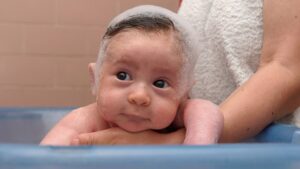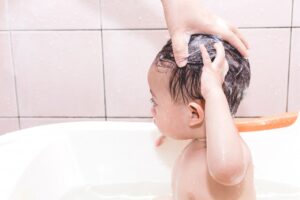Introduction
Regarding baby care, every detail matters, including how often you should wash your baby’s hair. Whether you’re a first-time parent or looking to refine your routine, understanding the best practices for baby hair care can save you time and protect your baby’s sensitive scalp. In this guide, we’ll explore everything you need to know about baby hair washing, including frequency, product recommendations, and solutions to common concerns like cradle caps.
Why Is Baby Hair Washing Important?
1. Hygiene and Comfort
Keeping your baby’s hair and scalp clean is essential for hygiene and comfort. Newborns and toddlers sweat and can accumulate dirt, even if their hair seems thin or sparse. Washing helps remove any oil buildup, dead skin cells, and environmental impurities.
2. Preventing Scalp Issues
Regular washing can prevent or minimize common scalp issues like cradle cap (seborrheic dermatitis). However, overwashing can lead to dryness and irritation, making a balanced routine crucial.
3. Bonding Time
Bath time often doubles as a bonding experience. Gently washing your baby’s hair provides a chance for you to connect with them while establishing a comforting routine.
How Often Should You Wash Baby Hair?
The frequency of washing varies based on age, activity level, and scalp condition. Let’s break it down:
1. Newborns (0-3 Months)
- Frequency: 1-2 times a week
Newborns have delicate scalps and minimal oil production. Washing too often can strip their scalp of its natural oils, leading to dryness. Use a gentle baby shampoo specifically designed for newborns.
2. Infants (3-12 Months)
- Frequency: 2-3 times a week
As your baby becomes more active and starts eating solid foods, their hair might need washing more frequently to remove sweat, food particles, and dirt. Still, avoid daily washing unless absolutely necessary to prevent dryness.
3. Toddlers (1 Year and Older)
- Frequency: 2-3 times a week or as needed
Toddlers are more mobile and likely to get dirty during playtime. Wash their hair when it appears greasy, has visible dirt, or smells sweaty.

Signs That Your Baby’s Hair Needs Washing
While a general routine works for most babies, be on the lookout for these signs that indicate it’s time for a wash:
- Visible dirt or food residue
- Greasy or oily appearance
- Noticeable odor
- Signs of cradle cap buildup
Choosing the Right Products for Baby Hair Washing
1. Baby Shampoo
Opt for shampoos that are:
- Tear-free
- Hypoallergenic
- Free of harsh chemicals like parabens and sulfates
2. Conditioner
For toddlers with longer or thicker hair, a light, baby-safe conditioner can help prevent tangles. Look for a product with natural ingredients like aloe vera or chamomile.
3. Tools
- Soft brush or comb: Helps gently detangle and stimulate the scalp.
- Hooded towel: Keeps your baby warm and comfortable after a wash.
How to Wash Baby Hair Step-by-Step
1. Prepare the Bath
- Fill the tub with warm (not hot) water.
- Have all your tools and products within arm’s reach.
2. Wet the Hair
- Use a cup or your hand to pour water gently over your baby’s head.
- Avoid getting water in their eyes or ears.
3. Apply Shampoo
- Pour a dime-sized amount of shampoo into your palm.
- Massage it gently into their scalp, focusing on areas with visible dirt or cradle cap.
4. Rinse Thoroughly
- Use clean, warm water to rinse away all shampoo.
- Ensure no residue is left behind, as this can lead to irritation.
5. Dry the Hair
- Pat the hair and scalp dry with a soft towel. Avoid rubbing, as this can irritate the skin.
Common Baby Hair Care Concerns
1. Cradle Cap
- What It Is: Yellow, scaly patches on the scalp.
- Solution: Use a soft brush to loosen flakes before washing. Apply a mild baby shampoo and rinse thoroughly.
2. Dry Scalp
- What It Is: Flaky, itchy skin caused by overwashing or cold weather.
- Solution: Limit hair washing to 1-2 times a week and use a moisturizer designed for babies.
3. Tangles in Toddler Hair
- What It Is: Knots in long or curly hair.
- Solution: Use a detangling spray or conditioner and a wide-tooth comb for gentle styling.
Tips for Maintaining a Healthy Baby Scalp
- Avoid Overwashing: Stick to the recommended frequency to prevent dryness.
- Keep Nails Trimmed: Babies may scratch their scalp, leading to irritation or infection.
- Protect from the Sun: Use a hat outdoors to shield your scalp from UV rays.

When to Consult a Pediatrician
If your baby experiences persistent scalp issues like redness, excessive flakes, or signs of infection, consult a pediatrician. They can recommend specialized treatments or identify underlying conditions.
FAQs About Washing Baby Hair
1. Can I use regular shampoo on my baby?
No, regular shampoos are too harsh for a baby’s sensitive scalp. Always use products specifically formulated for babies.
2. What if my baby hates hairwashing?
Try distracting them with toys or songs during bath time. Wash their hair last to minimize discomfort.
3. Should I wash my baby’s hair every day in hot weather?
Not necessarily. Use a damp cloth to wipe their scalp on non-washing days to keep it fresh.
4. Can I skip shampoo and use water only?
For newborns, this is often fine. However, older babies and toddlers may need shampoo to remove oils and dirt effectively.
5. How do I deal with thick or curly baby hair?
Use a baby-safe conditioner or detangler, and comb through gently with a wide-tooth comb to avoid breakage.
In conclusion, knowing how often to wash a baby’s hair depends on your child’s age, activity level, and specific scalp needs. With the right products and techniques, you can ensure their hair stays healthy and clean without irritation.

